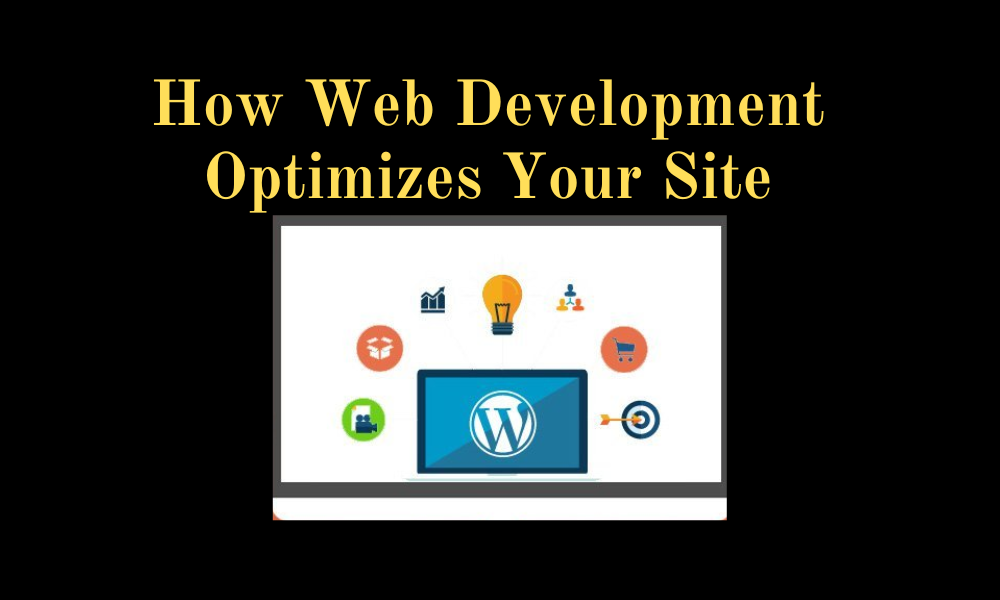Web development plays a crucial role in optimizing your site for better performance, user experience, and search engine visibility. Here’s a detailed guide on how web development optimizes your site and enhances your online presence:
Table of contents
What is Web Development?
Web development refers to the process of creating and maintaining websites. It involves various aspects such as web design, programming, database management, and server configuration. Web developers use programming languages like HTML, CSS, JavaScript, and frameworks like React or Angular to build functional and visually appealing websites

Responsive Design
Web development plays a crucial role in ensuring that your website is responsive, which means it adapts seamlessly to various devices such as smartphones, tablets, and desktops. This optimization not only enhances user experience but also significantly reduces bounce rates, ultimately leading to higher engagement and conversions.

By implementing responsive design, you create a user-friendly environment that encourages visitors to explore your site further, interact with your content, and ultimately convert into loyal customers or clients.
Faster Loading Speed
Optimized web development incorporates advanced techniques to significantly enhance loading speed, including code minification, image optimization, and leveraging caching mechanisms. These strategies not only boost user satisfaction by providing a seamless browsing experience but also have a positive impact on search engine rankings.

A faster-loading site not only retains visitors but also attracts new ones, contributing to improved engagement metrics and ultimately higher conversions.
SEO-Friendly Structure
Web developers implement SEO best practices, including clean code structure, proper use of headings and meta tags, and creating XML sitemaps. These efforts help search engines crawl and index your site efficiently, boosting its visibility in search results.

| SEO Best Practices | Explanation |
| Clean Code Structure | Ensure your website’s HTML and CSS are well-organized, free of errors, and follow semantic markup. This not only makes it easier for search engines to understand your content but also improves user experience by ensuring faster loading times and smooth navigation. |
| Proper Use of Headings | Use H1, H2, H3 headings hierarchy to outline content structure clearly and include relevant keywords. This helps search engines better understand the hierarchy of information on your page, improving the chances of ranking for targeted keywords and enhancing user readability. |
| Meta Tags | Optimize meta titles and descriptions with relevant keywords to improve click-through rates (CTR). Crafting compelling meta tags not only attracts clicks from search engine users but also provides a concise preview of your content, increasing the likelihood of engagement. |
| XML Sitemaps | Create XML sitemaps to help search engines crawl and index all pages of your site efficiently. XML sitemaps act as a roadmap for search engine bots, ensuring they discover and index all your website’s content, leading to improved visibility in search results. |
| Efficient Crawling and Indexing | By following these practices, search engines can understand and rank your site better in results. Implementing SEO best practices not only improves your site’s visibility but also enhances its overall performance and user satisfaction. |
Enhanced Security
Web development involves implementing robust security measures like SSL certificates, secure coding practices, and regular software updates. Understanding how web development optimizes your site through these security practices not only protects user data but also builds trust and credibility, which can improve search engine rankings.
In addition to these measures, implementing strong authentication methods such as two-factor authentication (2FA) can further enhance security. Regular security audits and penetration testing also play a crucial role in identifying and mitigating potential vulnerabilities.
Improved User Experience
Through web development, sites can offer a seamless user experience with intuitive navigation, clear calls-to-action (CTAs), and optimized forms. Positive user experiences lead to higher engagement metrics and repeat visits, signaling quality to search engines.

- Intuitive Navigation: Websites with intuitive navigation make it easy for users to find what they’re looking for, reducing bounce rates.
- Clear Calls-to-Action (CTAs): Well-designed CTAs prompt users to take desired actions, such as signing up and making a purchase.
- Optimized Forms: Streamlined and user-friendly forms improve user experience by reducing friction during sign-up or checkout processes, leading to higher completion rates and customer satisfaction.
- Higher Engagement Metrics: Positive user experiences result in increased engagement metrics like longer sessions, more page views, and lower bounce rates, indicating user satisfaction and interest in the content.
- Repeat Visits: When users have a seamless and enjoyable experience on a website, they are more likely to return, contributing to repeat visits and building a loyal user base.
Conclusion
Web development is a vital aspect of optimizing your site for success. Understanding how web development optimizes your site involves focusing on responsive design, faster loading speeds, an SEO-friendly structure, enhanced security, and improved user experience. By addressing these elements, you can create a site that ranks well in search engines and delights visitors.
Read more : How to Leverage Search Engine Optimization for Amazon Success
FAQs
Responsive design ensures your site looks great on all devices, meets user expectations, and improves SEO by reducing bounce rates.
Web development techniques like code optimization and image compression boost site speed, enhancing SEO and user experience.
SSL certificates, secure coding, and software updates are vital for web security and maintaining SEO rankings.
Web development prioritizes intuitive navigation, clear CTAs, and optimized forms for enhanced user experience and increased engagement.

Alex Mitch
Welcome to my blog! With over 10 years in digital marketing , I’ve seen its incredible impact on smaller businesses. Join me as we explore how digital marketing can grow your audience and boost your business. Whether you’re an experienced entrepreneur or just starting out, you’ll find practical tips and insights to enhance your digital marketing strategies.





